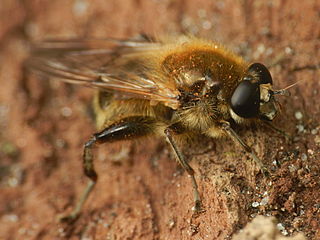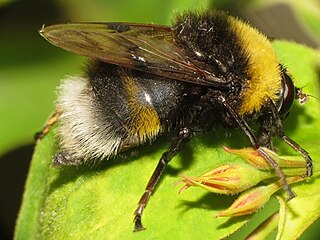
Paragus is a genus of hoverflies.

Hover flies of the genus Microdon are unusual among the Diptera. Like other members of the subfamily, they are myrmecophiles, meaning they inhabit the nests of ants.

Xylota is a Holarctic genus of hoverflies similar in structure to the related genera Chalcosyrphus and Brachypalpoides. As the larvae are saprophytic they're usually found in rotting wood. The adult flies are generally associated with woodland and woodland edges and can often be seen running over the upper sides of leaves. Unlike other syrphids the adults of many species rarely visit flowers preferring instead to gather pollen from leaf surfaces. There are over 100 described species of which 12 can be found in Europe. Seven species have been recorded in Britain. Identification of species has been difficult and identification by photographs is risky.

Spilomyia is a genus of hoverflies. Many species in the genus show Batesian mimicry of wasp models, including black and yellow patterns and modified antenna shape.

Eumerus is a genus of hoverflies, within the tribe Eumerini.

The genus Chrysotoxum consists of large, wasp-mimicking species. The adults are distinguished by very long antennae, oval abdomen with yellow stripes, and yellow patterns on the thoracic pleurae . The species of Chrysotoxum are chiefly Holarctic in distribution. . The species in this genus, are mostly very uniform in structure and colour and are separated with difficulty. Larvae are specialized in preying upon root aphids associated with ant nests.

Platycheirus is a large genus of hoverflies. They are also called sedgesitters.

Melangyna is a genus of hoverflies.

Melanostoma is a large genus of hoverflies. Little is known of their biology, but they are suspected to be general predators of small insects in leaf litter.

Chalcosyrphus is a genus of hoverflies in the subfamily Eristalinae. Many species exhibit some degree of mimicry of various sawflies and other hymenopterans and are often brightly coloured or metallic in hue. The adults are similar in structure and behavior to the related genus Xylota but differ in larval morphology. They can be found throughout Europe, Asia, and North America and seem to prefer damper, boggy habitats. The larvae are saproxylic feeders in rotten wood in these habitats.

Chrysogaster is a genus of small hoverflies in the subfamily Eristalinae. They are dark or black with shiny colourful reflections and can often be seen visiting flowers in damp marshy areas where the aquatic larvae live. Species in the related genera Melanogaster, Orthonevra, Lejogaster and Riponnensia were formerly treated as members of Chrysogaster.

Sphegina is a genus of small, slender hoverflies. They are widespread throughout Eurasia and North America. In flight they seem to have long hind legs which they often carry hanging down, making them resemble sphecid or ichneumonid wasps. Adult Sphegina are usually found in damp and shady habitats close to water in forested areas, and several species can often be found together. They often feed on white and yellow flowers of Apiaceae, Ranunculaceae, Asteraceae, and Rosaceae like Crataegus, Sorbus, and Sorbaria. Larvae nest in the sap of living and dead trees or in decaying cambium under tree bark lying in water or other damp conditions. The larvae of some species have been discovered in the tunnels of other xylophagous insects.

Orthonevra is a genus of fly in the Syrphidae family with at least 59 species identified so far. They are worldwide in distribution but concentrated in the Eastern North America and Europe.Orthonevra are commonly called Mucksuckers after the larvae which have been found in organic rich mud, i.e. muck. This genus belongs to the tribe Brachyopini that includes the prominent genera Melanogaster, Brachyopa, Neoascia and Sphegina. Orthonevra have black heads with blue to purple reflections. Many species have distinctive eye stripes. The antennae are somewhat elongate. The frons is wrinkled with silvery spots at sides of antennae. The thorax with small punctures dorsally and in several species the body is covered with scale-like pile. Wingd vein M1 curves away from the wing tip.(see images)

Pipiza is a genus Hoverflies, from the family Syrphidae, in the order Diptera. Most are dark hoverflies.

Brachypalpus is a genus of hoverflies, from the family Syrphidae, in the order Diptera. The head is triangular and produced well forwards and somewhat downwards. The thorax and abdomen with pile often rather long. The hind femur is swollen and with an obtuse spur apically and ventrally. The hind trochanters of male is spurred.
The larvae are of the rat-tailed type feeding on decaying sap under tree bark. Larvae live in decaying trees and logs. Larva and pupa have been described by Malloch.

Pocota is a genus hoverflies, from the family Syrphidae, in the order Diptera.

The Brachyopini is a tribe of hoverflies. Unlike many members of this family these flies are generally darker and less colourful though some genera contain species with an attractive metallic lustre e.g. Chrysogaster. Some like Brachyopa are associated with sap runs where their larvae feed on decaying sap. Others are found in boggy areas where their often semiaquatic larvae feed on decaying organic matter.

The Brachyopina is a subtribe of hoverflies.
Total of 245 species either found or highly expected to be found in New York.
















